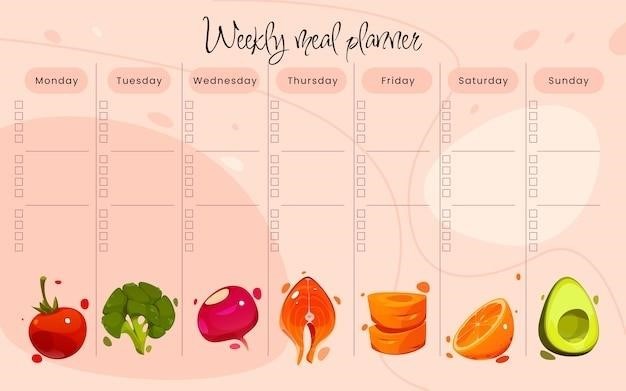Pneumatic Symbols PDF⁚ A Comprehensive Guide
This comprehensive guide provides a deep dive into the world of pneumatic symbols, offering a detailed understanding of their structure, function, and application in pneumatic circuit diagrams․ It covers essential topics such as standards and conventions, basic symbols, functional elements, flowlines and connections, conditioners and plant, pressure regulators and relief valves, actuators, valve symbol structure, valve functions, and a comprehensive symbol library․ This guide serves as a valuable resource for anyone involved in the design, implementation, or understanding of pneumatic systems, providing a clear and concise reference for interpreting and creating pneumatic schematics․
Introduction
Pneumatic systems, powered by compressed air, are ubiquitous in industrial automation, providing reliable and cost-effective solutions for a wide range of applications․ From simple actuators to complex control systems, understanding pneumatic symbols is crucial for anyone involved in the design, implementation, or maintenance of these systems․ Pneumatic symbols are a visual language that simplifies the representation of components and their interactions within a circuit․ They provide a standardized way to communicate design ideas, troubleshoot issues, and ensure consistency across projects․ This guide serves as a comprehensive resource for navigating the world of pneumatic symbols, demystifying their structure, function, and interpretation․
Whether you are a seasoned engineer or a novice learner, this guide provides a clear and concise explanation of the various symbols used in pneumatic schematics․ It covers the fundamental principles behind these symbols, exploring the logic behind their design and how they relate to real-world components․ Through detailed explanations and illustrative examples, this guide empowers readers to confidently interpret and create pneumatic diagrams, unlocking a deeper understanding of the inner workings of these versatile systems․
The guide delves into the essential elements of pneumatic symbols, including their structure, function, and how they are used to represent different components, such as valves, cylinders, actuators, and pressure regulators․ It also explores the use of symbols to depict flow paths, connections, and the various control mechanisms employed in pneumatic systems․ By providing a thorough understanding of these symbols, this guide equips readers with the knowledge and tools necessary to confidently navigate the world of pneumatic design and implementation․
Standards and Conventions
The world of pneumatic symbols is governed by a set of international standards and conventions that ensure consistency and clarity in communication․ These standards are crucial for promoting interoperability between different manufacturers, ensuring that engineers from various backgrounds can readily understand and interpret pneumatic diagrams․ Adherence to these standards is essential for avoiding confusion, misinterpretation, and potential errors in design and implementation․
The primary standard governing pneumatic symbols is ISO 1219-1, which provides a comprehensive framework for representing various pneumatic components and their functions․ This standard defines the basic shapes and symbols used to depict valves, cylinders, actuators, filters, regulators, and other essential elements of pneumatic systems․ It also outlines the conventions for depicting flow paths, connections, and control mechanisms, ensuring a consistent and unambiguous representation of pneumatic circuits․
In addition to ISO 1219-1, other relevant standards include ISO 9461, ISO 11727, and ISO 5599, which provide specific guidance on symbols for particular components or aspects of pneumatic systems․ These standards ensure a unified approach to symbol representation, fostering clarity and accuracy in pneumatic documentation and communication․ By understanding and adhering to these standards, engineers and technicians can confidently design, implement, and maintain pneumatic systems, knowing that their symbols will be understood and interpreted correctly by others․
Basic Symbols
The foundation of any pneumatic circuit diagram lies in a set of basic symbols that represent fundamental components and their functions․ These symbols are like a visual alphabet, forming the building blocks for more complex representations of pneumatic systems․ Mastering these basic symbols is essential for understanding and interpreting pneumatic schematics, as they provide a clear and concise visual language for communicating how pneumatic components interact within a circuit․
One of the most fundamental symbols is the rectangle, which represents a valve․ The number of squares within the rectangle indicates the number of positions the valve can assume, while lines within the rectangle represent flow paths․ Arrows on these lines indicate the direction of air flow, providing a clear visual representation of how the valve controls the movement of air․ Another fundamental symbol is the circle, which often represents a cylinder․ The circle’s size and shape can vary depending on the specific type of cylinder, but the symbol always conveys the function of the cylinder as a linear actuator, converting compressed air into linear motion․
Other basic symbols include triangles, which often represent directional control valves, and diamonds, which represent pressure regulators․ These symbols, along with lines and arrows, form the core vocabulary of pneumatic diagrams, allowing engineers and technicians to communicate the function and interaction of various components within a pneumatic system․ Understanding these basic symbols is the first step towards comprehending the complex language of pneumatic schematics, enabling a deeper understanding of how pneumatic systems operate and interact․
Functional Elements
Beyond the basic symbols, pneumatic diagrams incorporate functional elements that represent specific actions and behaviors within a pneumatic circuit․ These elements add layers of complexity and detail to the schematic, providing a comprehensive understanding of the system’s operation․ These elements are not just simple shapes but convey specific functions, allowing engineers to visualize and analyze the intended behavior of the pneumatic system․ For example, a “quick exhaust” symbol might be incorporated into a valve symbol, representing the rapid release of compressed air from a cylinder, ensuring a faster and more efficient return stroke․
These functional elements can also represent the actuation method of a component․ For example, a solenoid symbol might be added to a valve symbol to indicate that the valve is activated by an electrical signal․ This type of annotation provides valuable information about how the component is controlled and integrated into the overall system․ Other functional elements may represent specific features of a component, such as a “shuttle” symbol, which indicates a valve that can direct air flow to multiple ports, allowing for a more versatile and complex control scheme․ These functional elements are crucial for understanding the intricate interplay of components within a pneumatic system, providing a visual roadmap of the system’s logic and behavior․
Pneumatic diagrams are more than just static representations; they are dynamic visualizations of how a system operates․ Functional elements enhance this dynamic aspect, allowing engineers to understand not only the components themselves but also their interactions and the resulting actions within the system․ These elements serve as visual cues, guiding the understanding of how the pneumatic system responds to different inputs, ultimately contributing to the design, troubleshooting, and optimization of pneumatic applications․
Flowlines and Connections
Flowlines and connections are the visual arteries of pneumatic diagrams, representing the pathways of compressed air through the system․ These lines, often depicted as solid or dashed lines, connect various components, illustrating the direction and flow of air․ The type of line used can provide additional information, such as whether the air is flowing continuously or intermittently․ Solid lines typically represent continuous flow, while dashed lines indicate intermittent flow, such as a signal pulse or a controlled air release․ The direction of flow is usually indicated by arrows on the lines, making it clear how air travels through the system․
Connections between components are represented by specific symbols, indicating the type of joint or fitting used․ These symbols may represent various types of connections, including threaded fittings, quick-connect fittings, and hose connections․ These symbols provide crucial information for assembling and maintaining the pneumatic system, ensuring proper connections and preventing leaks․ The use of standardized symbols for connections ensures consistency and clarity in the diagram, facilitating communication between engineers and technicians involved in the design, assembly, and troubleshooting of the system․
Beyond representing physical connections, flowlines and connections convey the logic of the pneumatic system․ They depict how components interact, how air pressure is manipulated, and how signals are transmitted through the system․ By understanding the flowpaths, engineers can analyze the system’s behavior, identify potential bottlenecks, and optimize the system’s performance․ The clarity of flowlines and connections is essential for effective system design and maintenance, ensuring proper operation and minimizing downtime․ In essence, these elements are the visual language of pneumatic circuits, enabling engineers and technicians to communicate effectively and understand the intricate workings of these powerful systems․

Conditioners and Plant
Conditioners and plant components in pneumatic systems are crucial for ensuring the quality and reliability of compressed air, preparing it for use by actuators and other pneumatic devices․ These components, represented by specific symbols in pneumatic diagrams, play a vital role in removing contaminants, regulating pressure, and providing a consistent and controlled air supply․
Air filters are essential for removing particulate matter, moisture, and other contaminants from the compressed air․ These filters, often represented by a circle with a wavy line inside, prevent these contaminants from entering the system, potentially damaging actuators and other components․
Pressure regulators, depicted as a circle with a spring inside, maintain a consistent output pressure, regardless of fluctuations in the incoming air pressure․ These regulators ensure that actuators receive the correct pressure for optimal performance and prevent over-pressurization that could damage components․
Lubricators, represented by a circle with a drop of oil inside, add a controlled amount of lubricant to the compressed air, reducing friction and wear on actuators and other moving parts․ Lubrication is essential for extending the life of pneumatic components and ensuring smooth operation․
Driers, represented by a circle with a snowflake inside, remove moisture from the compressed air, preventing condensation and corrosion within the system․ Moisture removal is particularly important in environments with high humidity or in applications where condensation could lead to malfunctions․
These conditioners and plant components, often grouped together in air preparation units, create a clean, dry, and properly pressurized air supply, optimizing the performance and reliability of pneumatic systems․
Pressure Regulators and Relief Valves
Pressure regulators and relief valves are essential components in pneumatic systems, ensuring safe and controlled operation by managing pressure levels․ Pressure regulators, represented by a circle with a spring inside, maintain a consistent output pressure, regardless of fluctuations in the incoming air pressure․ This ensures that actuators receive the correct pressure for optimal performance, preventing over-pressurization that could damage components․
Relief valves, symbolized by a circle with a spring and a vertical line, act as safety devices, preventing excessive pressure buildup in the system․ When pressure exceeds a predetermined limit, the relief valve opens, releasing excess air, protecting components from potential damage․
Pressure regulators are often used in conjunction with relief valves, creating a pressure control system that ensures safe and efficient operation․ The regulator maintains a set output pressure, while the relief valve acts as a safety backup, preventing pressure from exceeding a critical threshold․
There are various types of pressure regulators and relief valves, each designed for specific applications․ Some regulators offer fine adjustment capabilities, while others are designed for high-pressure or high-flow applications․ Relief valves can be set to different pressure thresholds, depending on the needs of the pneumatic system․
Understanding the function and symbol representation of pressure regulators and relief valves is crucial for interpreting pneumatic diagrams and ensuring the safe and efficient operation of pneumatic systems․ These components play a vital role in preventing damage, ensuring optimal performance, and promoting system reliability․
Actuators
Actuators are the workhorses of pneumatic systems, converting compressed air energy into mechanical motion, enabling various tasks like linear movement, rotation, and clamping․ Pneumatic actuators are known for their robustness, reliability, and simple design, making them ideal for applications demanding high force and torque in harsh environments․
The most common type of actuator is the pneumatic cylinder, symbolized by a rectangle with a piston rod extending from one side․ Cylinders provide linear motion, pushing or pulling a load, depending on the direction of air flow․ They are available in various sizes, stroke lengths, and mounting configurations, catering to diverse applications․
Rotary actuators, represented by a circle with a shaft extending from the center, convert air pressure into rotational motion; They are used for tasks requiring precise rotation, such as valve actuation, clamping, and indexing․ Rotary actuators are commonly employed in automation systems, offering flexibility and control over rotational movements․
Pneumatic actuators are also used in grippers, which are designed to grasp and manipulate objects․ They are symbolized by a pair of parallel lines representing the jaws, with a piston rod connecting them․ Grippers are essential for tasks like part handling, assembly, and packaging, providing a secure and controlled grip on objects․
The choice of actuator depends on the specific application requirements, including force, speed, stroke length, and environmental conditions․ Understanding the symbols and functions of different actuators is crucial for selecting the appropriate component for a given pneumatic system, optimizing performance and ensuring reliable operation․
Valve Symbol Structure
Pneumatic valve symbols are meticulously designed to convey a wealth of information about the valve’s functionality, operation, and connection points․ Understanding the structure of these symbols is key to interpreting pneumatic circuit diagrams and designing efficient systems․
The core of a valve symbol is a rectangular box representing the valve body, with internal lines indicating the flow paths․ The number of squares within the box denotes the number of positions the valve can adopt, each representing a specific flow configuration․ Lines connecting to the box depict the inlet, outlet, and exhaust ports, indicating the direction of air flow․ Arrows within the lines signify the direction of air flow, with double arrows indicating bidirectional flow․
Additional symbols are incorporated to specify the valve’s actuation method, such as a solenoid for electrically actuated valves or a spring for spring-returned valves․ Operators, represented by circles or other symbols, indicate how the valve is controlled, such as manual, pneumatic, or electronic actuation․
Port marking, using letters or numbers, identifies each connection point, enabling clear identification of the inlet, outlet, and exhaust ports․ Function components, such as flow control elements or check valves, may be depicted within the symbol, providing a comprehensive understanding of the valve’s operation․
By carefully analyzing the structure of pneumatic valve symbols, engineers and technicians can effectively interpret circuit diagrams, understand the behavior of valves, and ensure the proper selection and integration of valves within pneumatic systems․
















